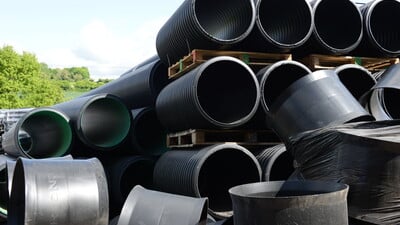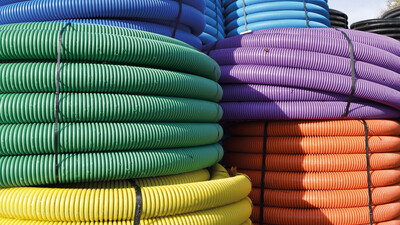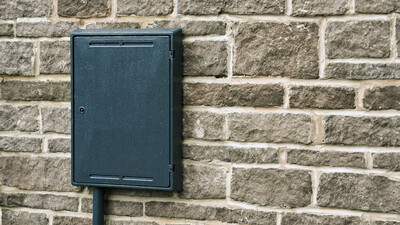
Underground ducting is the first line of defence in preventing damage to pipes or cables and protecting workers from injury or harm caused by rupturing gas pipes or electrical cables. It alkso enables pipes and cables to be installed or replaced after groundworks are complete without further excavation.
Our range includes underground ducting for gas, electrical and telecommunications supply plus a comprehensive selection of accessories for a complete installation
Why is ducting made in different colours?
Ducting is colour-coded to clearly show what services it is being used for and to warn workers so that they can take appropriate safety measures while working nearby.
- Black ducting is used for domestic electricity
- Blue ducting is used for water
- Yellow ducting is used for gas
- Grey ducting is used for telecoms
- Green ducting is used for cable TV and fibre optics
- Orange ducting is used for railway and street lighting
- Purple ducting is used for motorway lighting
- Red ducting is used for high-voltage electricity over 500W
What underground ducting should I use?
While this decision should be primarily based on using the correct colour code, ducting also varies in the plastic it is manufactured from, its rigidity and its performance.
Underground ducting is made of PVC, polyethylene, uPVC or twinwall HDPE plastic and is either flexible or rigid.
For short runs of ducting, 6-metre lengths of rigid PVC or twinwall HDPE (for extra strength) ducting may be your best option as these are much easier to lay than coiled flexible ducting.
For long runs, 25 or 50-metre coils of flexible PE or twinwall HDPE ducting might be better as this more easily accommodates variations in the ground level.
If your ducting requires extra strength, choose one with a suitable strength (SN rating) and crush resistance (kN) for your application; in general, a minimum compression strength of 450kN or an SN6 rating is sufficient. Twinwall HDPE, PE and uPVC ducting can all be manufactured with differing strength and crush-resistant properties.
BS EN 61386 specifies three class types for various applications:
Class 1 ducting
With a 450kN compression rating at operating temperatures of up to 75°C, Class 1 ducting should be used for high voltage (33-132kV) power supplies.
Class 2 ducting
This ducting also has a 450kN compression rating, but only up to operating temperatures of 50°C. it is therefore only suitable for low voltage (230V/11kV and 20kV) power supplies.
Class 3 ducting
Compression rated at 450kN only with operating temperatures of up to 23°C, this ducting is not suitable for electrical power ducting and can only be used for general applications.
Why is gas pipe ducting perforated?
Gas pipe ducting is perforated for a good reason. Should a gas leak occur in a pipe underground, the perforations will allow the gas to disperse away from the leak and into the surrounding soil. This prevents a high concentration of gas build-up and aids leak detection.
Help & Advice
Related articles
Delivery options
Enter your postcode for delivery timescales, accurate stock levels, and your nearest depot





